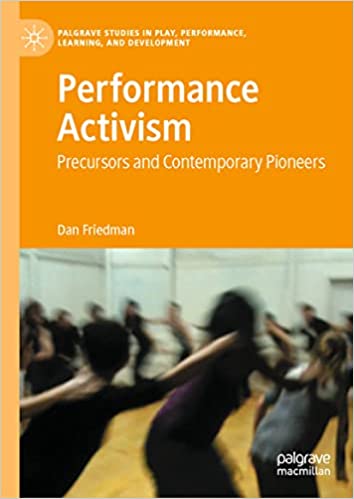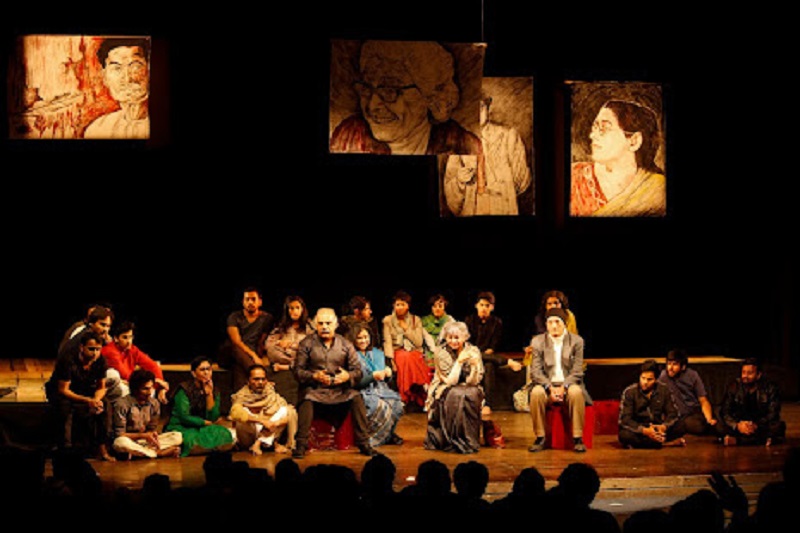Performance and acting are often conflated, confused, and combined.
Theatre artists, including many of us doing progressive theatre for social change, understand our work as putting on shows for audiences—and it is. We work on the assumption that providing the “right” message and/or the “right” emotional experience will help audience members understand the world more accurately and/or inspire them to change it.

At the same time, there is a social/political/artistic movement growing in various parts of the world that believes performance to be more than acting onstage (or on screen); indeed, it sees performance as a viable route to the transformative social and cultural development so desperately needed in this current century. This movement brings performance off the stage, outside the institutional constraints of the theatre, and invites all kinds of people to create performance and form ensembles. It has let loose performance in the classroom, the workplace, the community center, the hospital, the prison, the village square, the railroad platform, the political rally. In the process, performance is emerging as a means of engaging education, politics, and psychology. Performance is building bridges among antagonistic social groups, creating community dialogue, and reigniting creativity and curiosity in those who have had it beaten or starved or bombed out of them.
Now there’s a book about this movement. Performance Activism: Precursors and Contemporary Pioneers, published by Palgrave, draws on my work as founder and artistic director emeritus of the Castillo Theatre, a grassroots progressive theatre and community in New York City. I’ve been involved in progressive political theatre since 1969, when, as a member of the New York City Street Theatre Caravan, I performed all over the country for radical organizations, including the Black Panthers, the Young Lords, the American Indian Movement, and the United Farm Workers. Along the way, I earned a doctorate in theatre history from the University of Wisconsin, Madison. In this, my book-length study of performance activism, I explore how, over the course of the 20th century, performance has been loosened from the institutional theatre, and provide an overview of the contemporary performance activism movement from Zimbabwe to Colombia, from New York to New Delhi.
The following excerpt is from Chapter 14, “Healing Trauma.” It looks at one aspect of the work of Sanjay Kumar, a pioneer of performance activism in India.
Sanjay Kumar and the Pandies in Nithari
Sanjay Kumar is an associate professor of theatre at Hans Raj College of Delhi University in New Delhi, India. In 1987, he, along with some of his students, founded pandies’ theatre, which, as of this writing, has 150 members and brings performance and play-making to some of the most oppressed, brutalized, and marginalized populations in India. In Kumar’s words, pandies uses “a workshop-based mode of performance to allow the participants to grapple with their traumatic experiences and create performances that not only recreate harrowing moments from their past but also help them to articulate their visions and critiques of mainstream culture.”
Pandies started out doing conventional (albeit politically progressive) theatre. “We pride ourselves as being one of the few activist theatre groups in the country. But the origins of pandies are really very humble. We started as a college club theatre.” In India, being a college club theatre means participating in the annual university theatre competitions, putting on 35- to 40-minute plays, in English, primarily light entertainment. From the start, pandies did more serious, socially engaged (and, for the most part, longer) plays. For its first six years, the group produced progressive Third World writers such as Ngugi wa Thiong’o (Kenya) and Vincente Leñero (Mexico), along with progressive European playwrights such as Federico Garcia Lorca, Jean Genet, and Bertolt Brecht.
“We were doing avant-garde plays of the Left—Marxist, feminist—extremely conducive to the kind of environment that we lived in,” recalls Kumar. “Then we had fingers pointed at us. ‘Look at this abomination.’ ‘Look at the sexual content.’ ‘How graphic!’ ‘How ridiculous!’ Blah blah blah. And, of course, we were banned from working at the college.”
Forced off the campus in 1993, pandies began raising money to independently produce their plays, still doing what Kumar calls “proscenium theatre.” Pandies’ first off-campus production was Macbeth. Within two years, pandies were devising their own plays, with scripts being finalized by Kumar, along with Dr. Anand Prakash and Anuradha Marwah, two other pandies, on subjects including HIV and other issues facing sex workers, rape, LGBTQ rights, and the rights of the incarcerated.
By the turn of the century, pandies was moving from performing political plays on traditional stages to primarily doing a form of what we’re calling performance activism—which Kumar calls “workshop theatre”—with marginalized youth. What precipitated this shift, among other things, was the pogrom in 2002 in the state of Gujarat, during which at least 2,000 Muslims were massacred by their Hindu neighbors. “What really roused us,” said Kumar, “was the fact that the same [right-wing state] government that had been seen as responsible for this pogrom came back to power with an overwhelming majority, fueling its campaigns with the ‘glory’ of this violence.” (The party that ruled in Gujarat, the Bharatiya Janata Party or BJP, now controls the national government, and its chief minister, Narendra Modi, is now India’s prime minister.) In responding to the pogrom, pandies made a decision, Kumar writes, “to use the workshop mode of theatre with children of varying regions, classes, and religions to mitigate religious bigotry. A special focus was on marginalized children of slums and bastis who are targets of such bigotry.”

Kumar Sanjay and the pandies arrived in the New Delhi slum of Nithari soon after the news of atrocities there broke in the press. In December of 2006, after two years of children disappearing from Nithari and constant appeals to the local police, the cops finally moved in and discovered the limbs and rotting body parts of 53 children in the drains of the wealthy homes bordering the slum. “[It is] one of the most horrifying cases of cannibalism, and I mean cannibalism, of children that has ever taken place,” says Kumar. “It was literally a case of the rich eating the poor, not metaphorically the way it is all over the world.” Eventually a rich resident of the area surrounding Nithari and his servant were convicted of luring the children with goodies, then raping and killing them and chopping their bodies up and eating them. They were convicted in February 2009 and were both sentenced to death. Appeals have been filed against the sentences and the case continues in court.
Over the next five years the pandies worked with the siblings and friends of children who were killed. They were as young as 5 and as old as 17. The pandies began with daily workshops. “When we went to meet with them,” recalls Kumar, “we were met with the most unusual silence…They had been struck dumb by the horrible findings and the media stories that followed.” So the pandies worked on having the children perform silently. “Expressing [themselves] without words worked,” continues Kumar. “Through silent machines, the groups reenacted what they thought had happened in the house where the children—their siblings and neighbors—were killed.” Slowly, some of the participants began to open up, telling stories of how they had escaped abduction. From there, the young people began devising scripts, which included monologues and dialogue about their perceptions of the event and its causes.
“Is trauma cured, or at least lessened, by…going back to it and seeing it without the initial fear and shock?” Kumar wonders. “In this case, the answer could only be a partial affirmation. Emerging out of a stunned silence was only the beginning of facing the trauma. The participants and the facilitators, together with teachers and parents, decided that a public performance was essential. It would restore confidence and self-worth that had been lost in this episode.”
So in April 2007, less than half a year after the workshops had begun, a two-hour performance, which included the children and their pandies facilitators, was presented at the Habitat Centre in downtown Delhi. It was a montage that included the skits created by the children, a monologue by a girl who had escaped abduction, and reenactments of the games and exercises that had gone on in the workshops. The audience consisted almost exclusively of upper-middle-class and affluent theatregoers, precisely the audience the children and their families wanted to address. Says Kumar, “A performance before the oppressive rich was required—required to present their point of view from the margins before the class responsible, in the larger sense, for the trauma.”
Over the next three years the children of Nithari, working with the pandies, would devise and perform a total of seven public performances, each one growing out workshops and each one different. All were performed before well-to-do audiences, including, in a number of cases, politicians and government bureaucrats.
The pandies have been involved in Nithari, as of this writing, for over a decade. They no longer lead workshops or help devise plays. Instead they check in twice a year, both because they’ve become friends and also to see the work that the (now) young adults of Nithari are creating and producing on their own, including devising and producing their own plays—a development of which Kumar is particularly proud.
“I’ve seen these kids grow from waifs to young adults,” he reflects. “They’ve gone from the intense hatred, the intense anger, the intense trauma, to saying, ‘I don’t want to talk about that anymore. That is not all of who I am. Is that all you want to talk to us about? You think I can’t talk gender? You think I can’t talk politics? Why the very hell do you pick up your clothes and come here to talk to me about what happened in 2008?’
“The point is that the community is defining its own problems and seeking its own methodology to work out solutions, if there are any solutions possible. That kind of backing off [by the pandies] is very important…The little school that we started there, all the teachers are volunteers. No one is making a penny, no one is charged a penny. And they’re all from the community. Some teach theatre, and that’s something that’s gone on non-stop. Now they are the facilitators. Now they are the mentors.” He adds, “I’ve seen some fabulous plays they’ve created. Plays that posit questions that I did not even know existed.”
Dan Friedman is artistic director emeritus of the Castillo Theatre and is currently on the faculty of the East Side Institute, an international research and training center for social therapeutics and performance activism.


